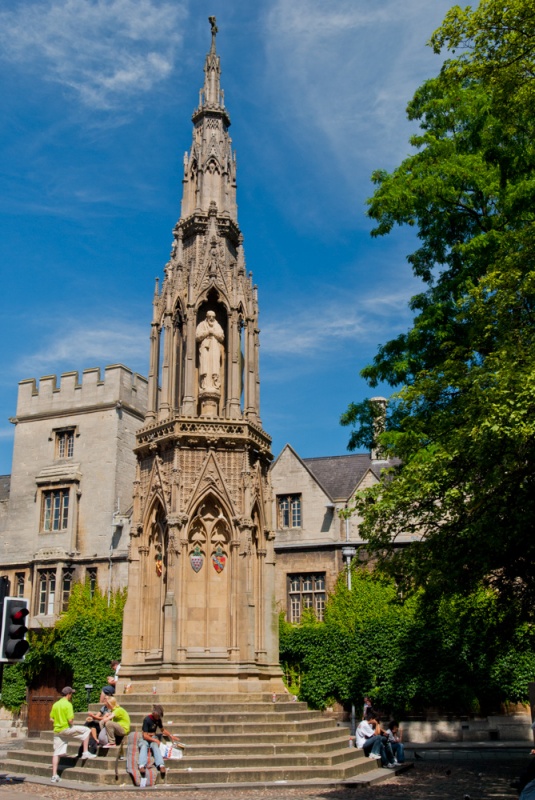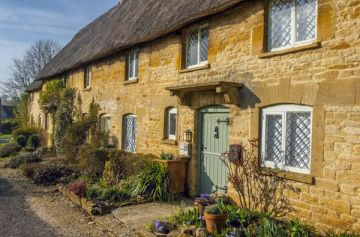
The Martyr's Memorial, where Broad Street meets St Giles, commemorates the deaths of three prominent Protestant church leaders, known as The Oxford Martyrs, during the reign of Queen Mary.

of the memorial
The Victorian Gothic memorial, which dates from 1838, has been likened to the spire of a sunken cathedral, and indeed the narrow central pole of the memorial resembles nothing so much as an ornate church spire.
History
When Mary I came to the throne in 1553 she tried to reverse the Protestant Reformation launched by her father, Henry VIII. Mary was a devout Catholic and wanted to return England to Catholic worship. She had Hugh Latimer, Bishop of Worcester, Nicholas Ridley, Archbishop of London, and Thomas Cranmer, Archbishop of Canterbury, imprisoned on a charge of heresy.
Ridley was targeted not just for his theology but because he had been a party to the attempt to put Lady Jane Grey on the throne instead of Mary, and had preached that both Mary and her sister Elizabeth were illegitimate.
The bishops were tried at the University Church (St Mary the Virgin), and you can still see where one of the pillars in the church nave was cut away to make a support for the platform on which the bishops stood for the trial. They were pressed to disavow their Protestant beliefs but refused.
Cranmer was given longer to appeal his sentence and was forced to watch as Bishops Latimer and Ridley were burned at the stake on 16 October 1555. The stake was sited in a ditch just outside the city wall. Ridley took longer to die, as packets of gunpowder tied to his body failed to ignite and end his suffering.
Archbishop Cranmer, perhaps overwhelmed by the death of his fellow bishops, recanted his Protestant beliefs and accepted the Pope as head of the Church. However, Mary doubted his sincerity and he was still burned at the stake like his fellows, on 21 March 1556.
Before he died he was allowed to preach a sermon at University Church, which he ended by rejecting his recantations and denouncing the Pope. He was taken from the church directly to the stake. He is said to have held the hand with which he had signed his recantation over the flames so that it should be burned first.
The flames from the pyre scorched a set of doors, which are now hung between the quads of Balliol College. The actual site of the burning is marked by an iron cross set in the pavement outside Balliol College on Broad Street. It is easy to miss the cross. It is on the north side of the road, but do watch for cyclists crossing this area if you step forward to have a closer look.
It is easy to think of Queen Mary as the villain of the story, but it is worth remembering that the three martyrs were not always the most pleasant people you would care to meet. Latimer played a role in getting John Forest, a Catholic, burned at the stake under Henry VIII and even preached a sermon at his execution. Cranmer helped convict the protestant John Frith to death, though he later came to share Frith's views.
The city of Oxford had to bear the cost of keeping the bishops. Records show that the cost of supplying the faggots used to burn Archbishop Cranmer were charged to his expense account, which the city tried to claim back from the Archbishop of Canterbury.
Why was the Memorial built?
Why erect a memorial to the Oxford Martyrs some 300 years after their deaths? The memorial was built by public subscription, but the reason why it was deemed appropriate to erect a memorial to Protestant martyrs says a lot about the state religious turmoil in the 1840s.
The Anglican church in Victorian England was worried by 'High Church' movements like Tractarianism, which argued for a return to a more Catholic form of worship. The memorial was a symbol to remind not just Oxford residents but the whole of English society that the early founders of Anglicanism had been killed by Catholics for their beliefs.
In November 1830 the Martyrs' Memorial Committee was established to launch a public appeal to set up a suitable monument to warn the public against neo-Catholicism. The Committee decided to base the monument on the design of the Eleanor Crosses erected by Edward I in memory of his wife, Eleanor of Castile. The cross at Waltham was chosen as the model for the memorial, and a competition was held to select an architect.
The memorial was designed by Sir George Gilbert Scott, one of the most important architects of the Victorian period. Scott also rebuilt the nearby church of St Mary Magdalen to compliment the memorial. His design shows Latimer facing west, his arms crossed on his chest. Ridley faces east, and Cranmer holds a Bible and faces north.
The base of the memorial is inscribed with the following words:
'To the Glory of God, and in grateful commemoration of His servants, Thomas Cranmer, Nicholas Ridley, Hugh Latimer, Prelates of the Church of England, who near this spot yielded their bodies to be burned, bearing witness to the sacred truths which they had affirmed and maintained against the errors of the Church of Rome, and rejoicing that to them it was given not only to believe in Christ, but also to suffer for His sake; this monument was erected by public subscription in the year of our Lord God, MDCCCXLI.'
The body of the memorial was carved from magnesian limestone, but the figures of the Martyrs were carved from Caen stone obtained from Canterbury Cathedral. The sculptor was Henry Weekes, and though his carvings were beautifully crafted, his choice of material was unfortunate. Despite the fact that the figures were partially protected by the statue niches in which they stood, the effects of weathering made them wear severely, forcing a full restoration in 2003.
The memorial is easy to access. It stands on a large traffic island at the southern end of St Giles, just off the west end of Broad Street.
For a more thorough look at the events culminating in the deaths of the Oxford Martyr's see our Oxford History section.
About Martyr's Memorial
Address: Magdalen Street,
Oxford,
Oxfordshire,
England
Attraction Type: Historic Building - Monument
Location: At the southern end of St Giles, off Broad Street. Open site. The nearest post code is OX1 3AE.
Location map
OS: SP512065
Photo Credit: David Ross and Britain Express
HERITAGE
 We've 'tagged' this attraction information to help you find related historic attractions and learn more about major time periods mentioned.
We've 'tagged' this attraction information to help you find related historic attractions and learn more about major time periods mentioned.
Historic Time Periods:
Find other attractions tagged with:
Gilbert Scott (Person) - Mary I (Person) - Medieval (Time Period) - Reformation (Historical Reference) - Victorian (Time Period) -
NEARBY HISTORIC ATTRACTIONS
Heritage Rated from 1- 5 (low to exceptional) on historic interest
Oxford, St Mary Magdalen Church - 0 miles (Historic Church) ![]()
Ashmolean Museum - 0.1 miles (Museum) ![]()
Balliol College - 0.1 miles (Historic Building) ![]()
St John's College, Oxford - 0.1 miles (Historic Building) ![]()
Oxford, St Michael at the North Gate Church - 0.1 miles (Historic Church) ![]()
Trinity College, Oxford - 0.1 miles (Historic Building) ![]()
Jesus College, Oxford - 0.1 miles (Historic Building) ![]()
Oxford, Exeter College - 0.1 miles (Historic Building) ![]()
Nearest Holiday Cottages to Martyr's Memorial:
Witney, Oxfordshire
Sleeps: 4
Stay from: £558 - 1793
Eynsham, Oxfordshire
Sleeps: 4
Stay from: £558 - 1808
More self catering near Martyr's Memorial









